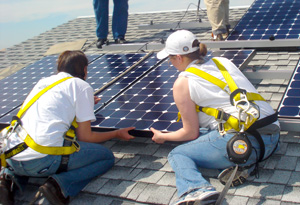Reduce, Reuse, Recycle—Redefine

Photo: Kristina Beverlin
In celebration of the 40th anniversary of Earth Day, Simran Sethi finds herself taking a cold, hard look at what being an "environmentalist" means—it's a commitment that will take you far beyond just changing your shopping habits.
At the beginning of every academic semester, I ask my students if they've enrolled in my classes to "learn the answers." Eager to please, most of them nod their heads. Yes, they are here to learn the answers. And then I say, "I am here to help you ask really good questions. The answers, you will discover for yourself."I say the same to you, dear readers, on the cusp of the 40th anniversary of Earth Day. In spring of 1970, 20 million people from all over the country showed their support for the planet by engaging in environmental teach-ins modeled after the peace teach-ins against the Vietnam War. They sat in high school gymnasiums, public parks and places of worship. And they set the stage for groundbreaking legislation: the Clean Air Act of 1970, dedicated to protecting and improving air quality; the Clean Water Act of 1972, which regulated the amount of pollutants discharged into our water and preserved the quality of our surface waters; and the Endangered Species Act of 1973, designed to conserve plants and animals in danger of dwindling or disappearing.
Today, every one of those legislative victories is under threat. Carcinogens flood our waters while polluting industries compromise our air. The species in danger of disappearing are low-income communities of color and other communities that lack political and economic clout—the places where our most toxic industries are located. These areas have been renamed after the havoc they wreak: "Cancer Alley" in the river parishes of Louisiana and "Asthma Town" in Huntington Park, Los Angeles.
This year, when you embrace the day and embark on efforts to "go green," I humbly request that you go beyond reducing, reusing and recycling to redefining what this movement means to you. Being environmentally friendly is about more than buying different stuff—it's about understanding the relationship we have with our environment and with each other. It's about acknowledging that, while we don't all have equal access to natural resources—as detailed in my environmental justice series The Good Fight—we all want clean water, safe air and good soil. We all want our children to be healthy and our communities to be safe. The public perception that "blue states" care more about the environment than "red states" do, and the rich care more than the poor, is false. We know this: No one political party, no one socio-economic group, no one race or gender has a monopoly on caring for the planet and each other.



